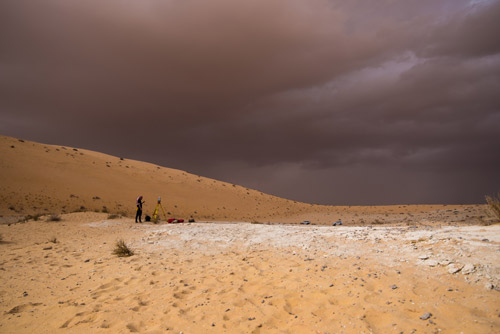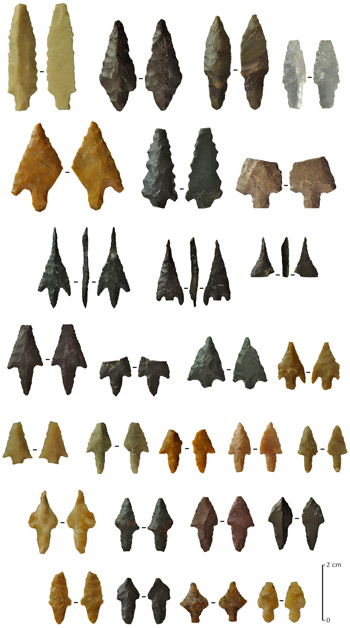Using AI to control energy for indoor agriculture
30 September 2024
Published online 9 April 2018
Discussing the advent of archaeology in Saudi Arabia with the head of the Palaeodeserts Project.

© Klint Janulis
The Palaeodeserts team is based at the Max Planck Institute for the Science of Human History in Jenna, Germany and works in cooperation with their main partners at the Saudi Commission for Tourism and National Heritage (SCTH). Nature Middle East spoke to Michael Petraglia, the project’s leader.
Nature Middle East: Tell me about the Palaeodeserts Project.
Michael Petraglia: We’re made up of a whole variety of scientists reconstructing the ancient environment. Saudis are among people from all over the world who are very heavily involved — there are around 40 institutions involved in this project. There are some large-scale interdisciplinary projects that operate around the world, but this is pretty unique for Arabia itself. I think it’s the only project of its size and inter-disciplinary nature.
There were lots of lakes and rivers all across Arabia, and there was plenty of grass with vegetation.
NME: How important is Arabian archaeology to the human story?
MP: Look where Arabia sits relative to Africa and the rest of Eurasia and you will see that it is at a critical junction between the continents. Believe it or not, Arabia was never part of the story of human evolution and the more recent crossroads of cultures in the last 10,000 years. Though we knew there were a lot of archaeological sites, in-depth scientific interdisciplinary work had been scant, and we have rectified that situation.
Now Arabia is at the forefront of a lot of work that we talk about, for example migrations out of Africa, thanks to all the discoveries we’ve been making in Arabia. People had thought it might be an important crossroads, but now we have the evidence.
NME: What has the team unearthed about the ancient environment of Saudi Arabia?
MP: One of the first things that we did was remote sensing. We looked at satellite images for example, and found that there are literally thousands of ancient rivers that crisscrossed Saudi Arabia. We also now count 10,000 ancient lakes.
The most amazing thing, to me, are the fossil finds. They say something about the kinds of animals that could migrate into Arabia. We have fossils of elephants; these were gigantic creatures, much larger than the African elephant. Amazingly, we also have hippos. These finds tell you something of how wet it really was. Because hippos cannot survive in very arid and dry situations, so the environment had to be green for them to survive. So, there were surely lots of lakes and rivers all across Arabia, and there was plenty of grass with vegetation for these animals to consume.
So far, we’ve dated sites to the last 500,000 years, during which the Earth’s climate has shifted We’ve seen that archaeological sites correspond with every single wet phase.
NME: How did ancient humans respond to climate change in Arabia?
MP: We think that as soon as the climate became wet, our species, and earlier forms of humans, moved in and there was an expansion of hunting and gathering societies.

© The Palaeodeserts Project
There are a few options. One is that you can’t continue to survive out there. We know that. You get trapped, you could go extinct or you could contract to certain zones. There are zones today, for example, in Oman that are in fact very wet and receive monsoonal rainfall. So, it’s possible that populations moved to these smaller areas that could sustain humans.
Or, you could simply move on. You’re a hunter and gatherer, you’re already mobile, so if things dry up, you could just continue to move across Eurasia. We think that’s exactly what went on.
NME: When did Arabia start to become the arid desert we see today?
MP: Around 5,000 years ago Arabia started drying up, but the people of Arabia were very clever; they did new and innovative things. They started to incorporate domesticated animals and even domesticated plants into their economies and they started to dig underground wells, which allowed them to survive through droughts.
Life became very different. People started settling in oases. Later on, camels came in and became very important; it allowed people to be connected from one oasis to the other and to trade and exchange goods across those arid landscapes. That picture is only the last few thousand years. It’s not ancient picture. It’s a very new life way that started to form in the last 10,000 years. Before that there were only hunter gathers.
NME: How is archaeology changing in Saudi Arabia?
MP: It has changed tremendously in the last 10 years and there’s now a tremendous focus on archaeology in the country: there are foreign missions working with the Saudis and the amount of evidence coming out is probably doubling every year. There’s also a lot more sophisticated research, and the Saudis have been supportive and promoting it.
We just successfully completed the first drill core in Saudi Arabia, which is going to tell us a lot about environmental history. Saudi Aramco came to the table and drilled a core from one of our ancient lakes called Jubbah in north central Arabia and we think we have a record now from the contemporary world all the way back to about a million years ago.
This huge for us, because right now when we go to the lakes, you can only see certain windows of time.
We have about 80m of drill core sediments, which were mailed to our labs here in Germany and now we’ve put together a large consortium of scientists to study those drill cores, because we can reconstruct the environment through time.
doi:10.1038/nmiddleeast.2018.44
Stay connected: